Online Shopping in Ireland: Economic Impact on the Retail Sector
VerifiedAdded on 2022/10/19
|16
|4449
|130
Report
AI Summary
This report provides a comprehensive analysis of online shopping within the Irish retail sector. It begins by comparing and contrasting primary data with secondary Irish sources to assess the current state of the industry. The report then delves into the influence of online shopping on the growth of the Irish economy, highlighting its positive impacts. Furthermore, it examines the effects of online retail on international trade and tax/VAT, providing insights into the broader economic implications. The analysis extends to predicting the future of online shopping in Ireland, considering emerging trends and potential developments. Finally, a concluding summary synthesizes the key findings and provides a cohesive overview of the topic, emphasizing the dynamic nature of the online retail landscape in Ireland and its significance for the economy. The study utilizes Irish sources to provide context and evidence for the analysis, making it relevant for understanding the current market dynamics.
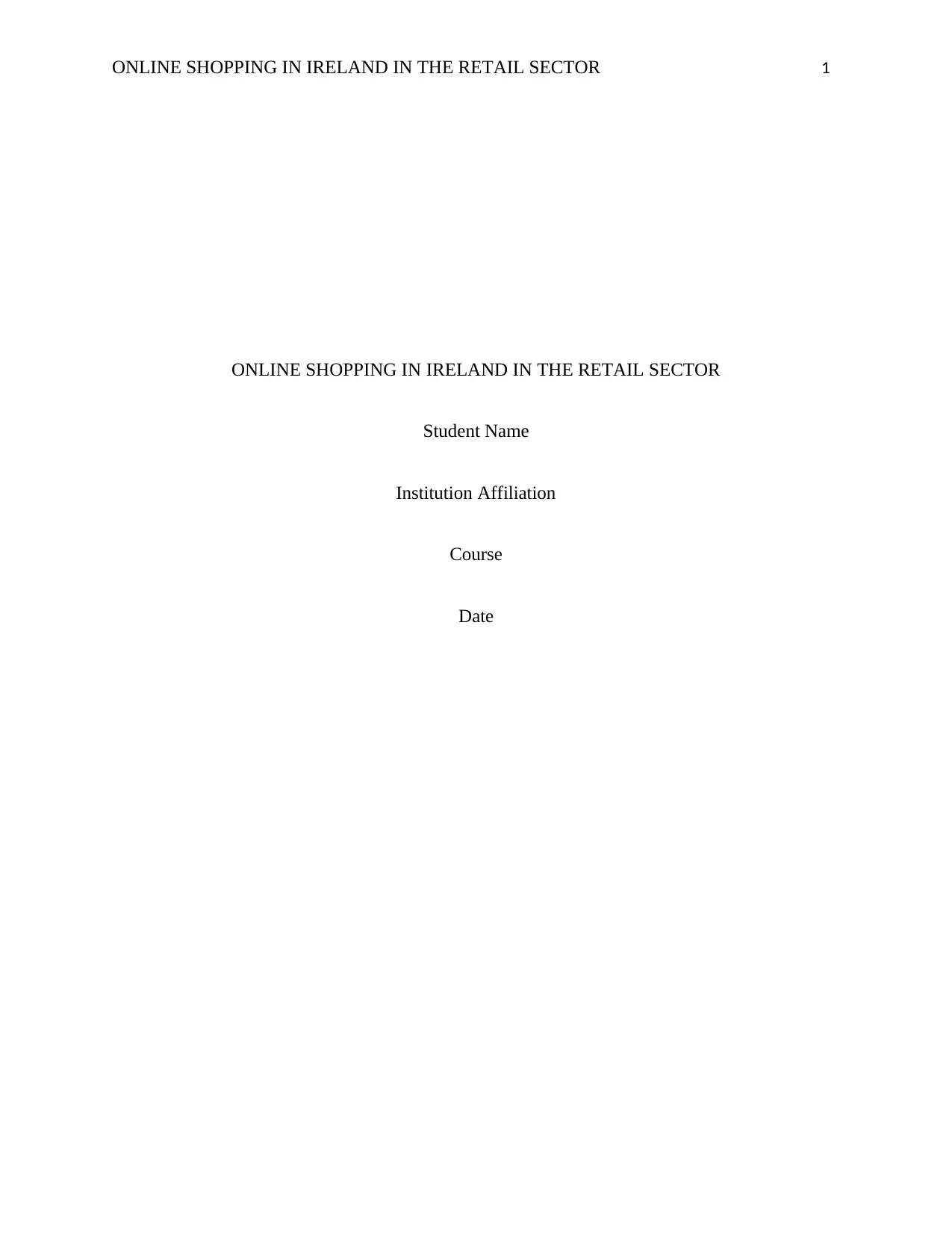
ONLINE SHOPPING IN IRELAND IN THE RETAIL SECTOR 1
ONLINE SHOPPING IN IRELAND IN THE RETAIL SECTOR
Student Name
Institution Affiliation
Course
Date
ONLINE SHOPPING IN IRELAND IN THE RETAIL SECTOR
Student Name
Institution Affiliation
Course
Date
Paraphrase This Document
Need a fresh take? Get an instant paraphrase of this document with our AI Paraphraser
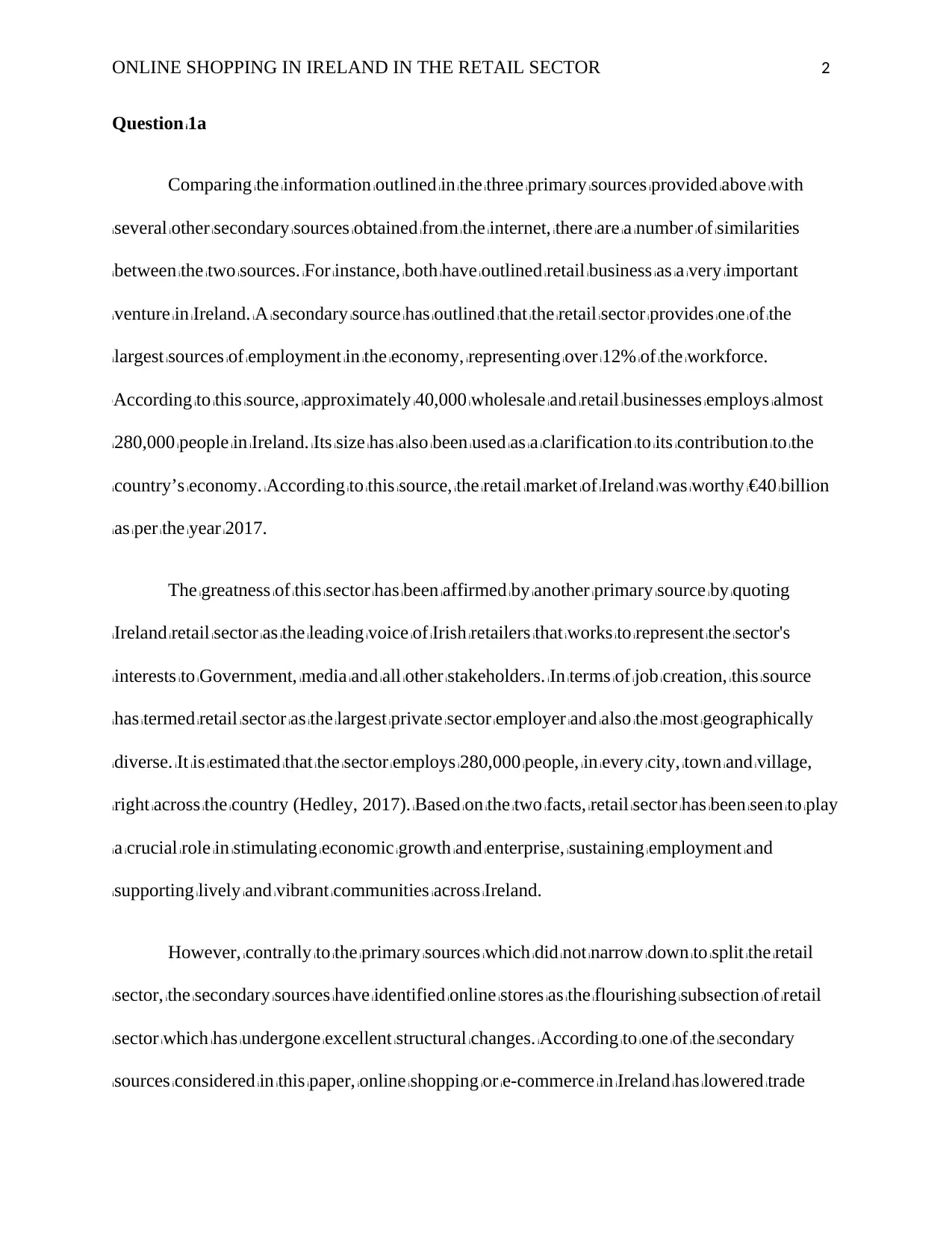
ONLINE SHOPPING IN IRELAND IN THE RETAIL SECTOR 2
Question i1a
Comparing ithe iinformation ioutlined iin ithe ithree iprimary isources iprovided iabove iwith
iseveral iother isecondary isources iobtained ifrom ithe iinternet, ithere iare ia inumber iof isimilarities
ibetween ithe itwo isources. iFor iinstance, iboth ihave ioutlined iretail ibusiness ias ia ivery iimportant
iventure iin iIreland. iA isecondary isource ihas ioutlined ithat ithe iretail isector iprovides ione iof ithe
ilargest isources iof iemployment iin ithe ieconomy, irepresenting iover i12% iof ithe iworkforce.
iAccording ito ithis isource, iapproximately i40,000 iwholesale iand iretail ibusinesses iemploys ialmost
i280,000 ipeople iin iIreland. iIts isize ihas ialso ibeen iused ias ia iclarification ito iits icontribution ito ithe
icountry’s ieconomy. iAccording ito ithis isource, ithe iretail imarket iof iIreland iwas iworthy i€40 ibillion
ias iper ithe iyear i2017.
The igreatness iof ithis isector ihas ibeen iaffirmed iby ianother iprimary isource iby iquoting
iIreland iretail isector ias ithe ileading ivoice iof iIrish iretailers ithat iworks ito irepresent ithe isector's
iinterests ito iGovernment, imedia iand iall iother istakeholders. iIn iterms iof ijob icreation, ithis isource
ihas itermed iretail isector ias ithe ilargest iprivate isector iemployer iand ialso ithe imost igeographically
idiverse. iIt iis iestimated ithat ithe isector iemploys i280,000 ipeople, iin ievery icity, itown iand ivillage,
iright iacross ithe icountry (Hedley, 2017). iBased ion ithe itwo ifacts, iretail isector ihas ibeen iseen ito iplay
ia icrucial irole iin istimulating ieconomic igrowth iand ienterprise, isustaining iemployment iand
isupporting ilively iand ivibrant icommunities iacross iIreland.
However, icontrally ito ithe iprimary isources iwhich idid inot inarrow idown ito isplit ithe iretail
isector, ithe isecondary isources ihave iidentified ionline istores ias ithe iflourishing isubsection iof iretail
isector iwhich ihas iundergone iexcellent istructural ichanges. iAccording ito ione iof ithe isecondary
isources iconsidered iin ithis ipaper, ionline ishopping ior ie-commerce iin iIreland ihas ilowered itrade
Question i1a
Comparing ithe iinformation ioutlined iin ithe ithree iprimary isources iprovided iabove iwith
iseveral iother isecondary isources iobtained ifrom ithe iinternet, ithere iare ia inumber iof isimilarities
ibetween ithe itwo isources. iFor iinstance, iboth ihave ioutlined iretail ibusiness ias ia ivery iimportant
iventure iin iIreland. iA isecondary isource ihas ioutlined ithat ithe iretail isector iprovides ione iof ithe
ilargest isources iof iemployment iin ithe ieconomy, irepresenting iover i12% iof ithe iworkforce.
iAccording ito ithis isource, iapproximately i40,000 iwholesale iand iretail ibusinesses iemploys ialmost
i280,000 ipeople iin iIreland. iIts isize ihas ialso ibeen iused ias ia iclarification ito iits icontribution ito ithe
icountry’s ieconomy. iAccording ito ithis isource, ithe iretail imarket iof iIreland iwas iworthy i€40 ibillion
ias iper ithe iyear i2017.
The igreatness iof ithis isector ihas ibeen iaffirmed iby ianother iprimary isource iby iquoting
iIreland iretail isector ias ithe ileading ivoice iof iIrish iretailers ithat iworks ito irepresent ithe isector's
iinterests ito iGovernment, imedia iand iall iother istakeholders. iIn iterms iof ijob icreation, ithis isource
ihas itermed iretail isector ias ithe ilargest iprivate isector iemployer iand ialso ithe imost igeographically
idiverse. iIt iis iestimated ithat ithe isector iemploys i280,000 ipeople, iin ievery icity, itown iand ivillage,
iright iacross ithe icountry (Hedley, 2017). iBased ion ithe itwo ifacts, iretail isector ihas ibeen iseen ito iplay
ia icrucial irole iin istimulating ieconomic igrowth iand ienterprise, isustaining iemployment iand
isupporting ilively iand ivibrant icommunities iacross iIreland.
However, icontrally ito ithe iprimary isources iwhich idid inot inarrow idown ito isplit ithe iretail
isector, ithe isecondary isources ihave iidentified ionline istores ias ithe iflourishing isubsection iof iretail
isector iwhich ihas iundergone iexcellent istructural ichanges. iAccording ito ione iof ithe isecondary
isources iconsidered iin ithis ipaper, ionline ishopping ior ie-commerce iin iIreland ihas ilowered itrade
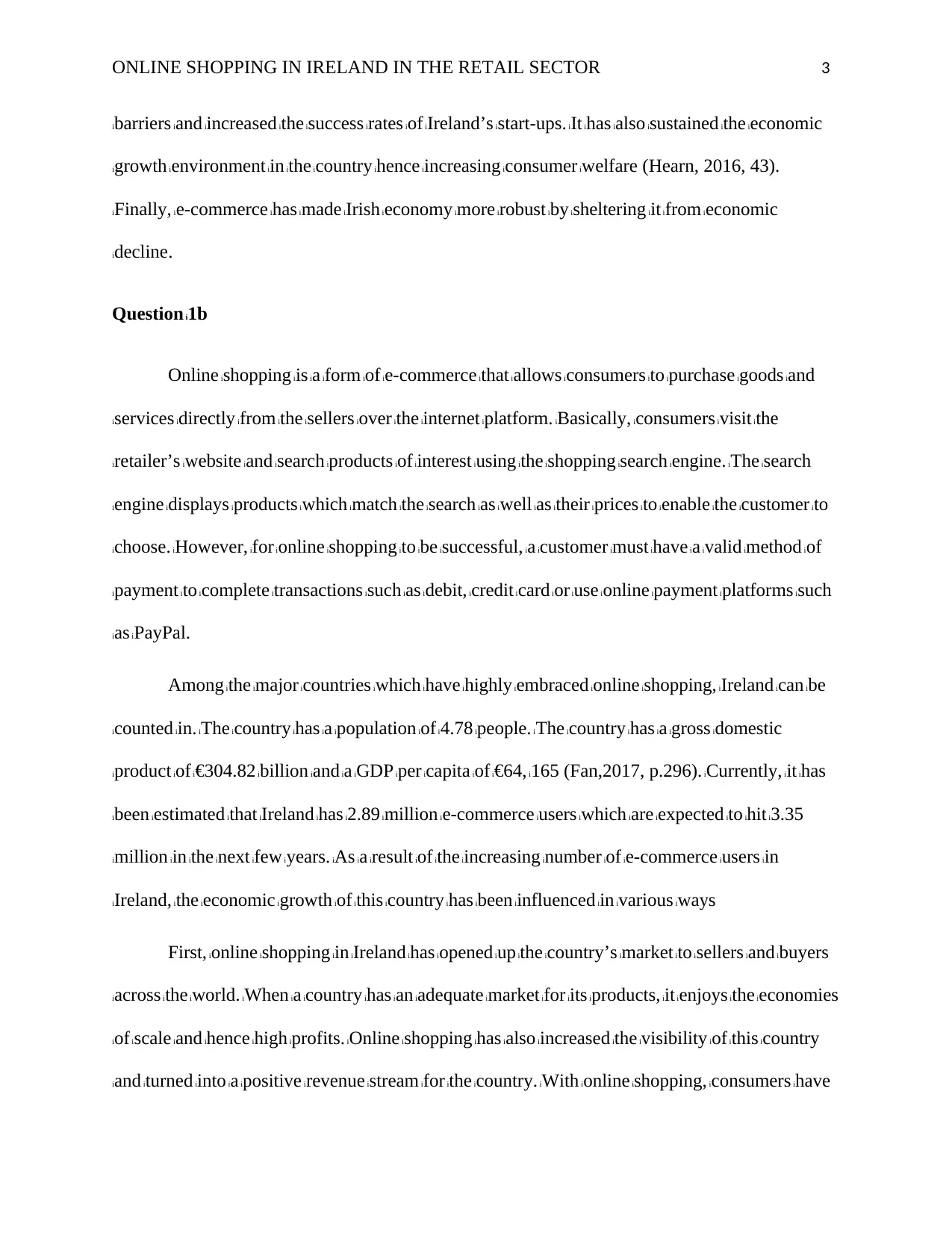
ONLINE SHOPPING IN IRELAND IN THE RETAIL SECTOR 3
ibarriers iand iincreased ithe isuccess irates iof iIreland’s istart-ups. iIt ihas ialso isustained ithe ieconomic
igrowth ienvironment iin ithe icountry ihence iincreasing iconsumer iwelfare (Hearn, 2016, 43).
iFinally, ie-commerce ihas imade iIrish ieconomy imore irobust iby isheltering iit ifrom ieconomic
idecline.
Question i1b
Online ishopping iis ia iform iof ie-commerce ithat iallows iconsumers ito ipurchase igoods iand
iservices idirectly ifrom ithe isellers iover ithe iinternet iplatform. iBasically, iconsumers ivisit ithe
iretailer’s iwebsite iand isearch iproducts iof iinterest iusing ithe ishopping isearch iengine. iThe isearch
iengine idisplays iproducts iwhich imatch ithe isearch ias iwell ias itheir iprices ito ienable ithe icustomer ito
ichoose. iHowever, ifor ionline ishopping ito ibe isuccessful, ia icustomer imust ihave ia ivalid imethod iof
ipayment ito icomplete itransactions isuch ias idebit, icredit icard ior iuse ionline ipayment iplatforms isuch
ias iPayPal.
Among ithe imajor icountries iwhich ihave ihighly iembraced ionline ishopping, iIreland ican ibe
icounted iin. iThe icountry ihas ia ipopulation iof i4.78 ipeople. iThe icountry ihas ia igross idomestic
iproduct iof i€304.82 ibillion iand ia iGDP iper icapita iof i€64, i165 (Fan,2017, p.296). iCurrently, iit ihas
ibeen iestimated ithat iIreland ihas i2.89 imillion ie-commerce iusers iwhich iare iexpected ito ihit i3.35
imillion iin ithe inext ifew iyears. iAs ia iresult iof ithe iincreasing inumber iof ie-commerce iusers iin
iIreland, ithe ieconomic igrowth iof ithis icountry ihas ibeen iinfluenced iin ivarious iways
First, ionline ishopping iin iIreland ihas iopened iup ithe icountry’s imarket ito isellers iand ibuyers
iacross ithe iworld. iWhen ia icountry ihas ian iadequate imarket ifor iits iproducts, iit ienjoys ithe ieconomies
iof iscale iand ihence ihigh iprofits. iOnline ishopping ihas ialso iincreased ithe ivisibility iof ithis icountry
iand iturned iinto ia ipositive irevenue istream ifor ithe icountry. iWith ionline ishopping, iconsumers ihave
ibarriers iand iincreased ithe isuccess irates iof iIreland’s istart-ups. iIt ihas ialso isustained ithe ieconomic
igrowth ienvironment iin ithe icountry ihence iincreasing iconsumer iwelfare (Hearn, 2016, 43).
iFinally, ie-commerce ihas imade iIrish ieconomy imore irobust iby isheltering iit ifrom ieconomic
idecline.
Question i1b
Online ishopping iis ia iform iof ie-commerce ithat iallows iconsumers ito ipurchase igoods iand
iservices idirectly ifrom ithe isellers iover ithe iinternet iplatform. iBasically, iconsumers ivisit ithe
iretailer’s iwebsite iand isearch iproducts iof iinterest iusing ithe ishopping isearch iengine. iThe isearch
iengine idisplays iproducts iwhich imatch ithe isearch ias iwell ias itheir iprices ito ienable ithe icustomer ito
ichoose. iHowever, ifor ionline ishopping ito ibe isuccessful, ia icustomer imust ihave ia ivalid imethod iof
ipayment ito icomplete itransactions isuch ias idebit, icredit icard ior iuse ionline ipayment iplatforms isuch
ias iPayPal.
Among ithe imajor icountries iwhich ihave ihighly iembraced ionline ishopping, iIreland ican ibe
icounted iin. iThe icountry ihas ia ipopulation iof i4.78 ipeople. iThe icountry ihas ia igross idomestic
iproduct iof i€304.82 ibillion iand ia iGDP iper icapita iof i€64, i165 (Fan,2017, p.296). iCurrently, iit ihas
ibeen iestimated ithat iIreland ihas i2.89 imillion ie-commerce iusers iwhich iare iexpected ito ihit i3.35
imillion iin ithe inext ifew iyears. iAs ia iresult iof ithe iincreasing inumber iof ie-commerce iusers iin
iIreland, ithe ieconomic igrowth iof ithis icountry ihas ibeen iinfluenced iin ivarious iways
First, ionline ishopping iin iIreland ihas iopened iup ithe icountry’s imarket ito isellers iand ibuyers
iacross ithe iworld. iWhen ia icountry ihas ian iadequate imarket ifor iits iproducts, iit ienjoys ithe ieconomies
iof iscale iand ihence ihigh iprofits. iOnline ishopping ihas ialso iincreased ithe ivisibility iof ithis icountry
iand iturned iinto ia ipositive irevenue istream ifor ithe icountry. iWith ionline ishopping, iconsumers ihave
⊘ This is a preview!⊘
Do you want full access?
Subscribe today to unlock all pages.

Trusted by 1+ million students worldwide
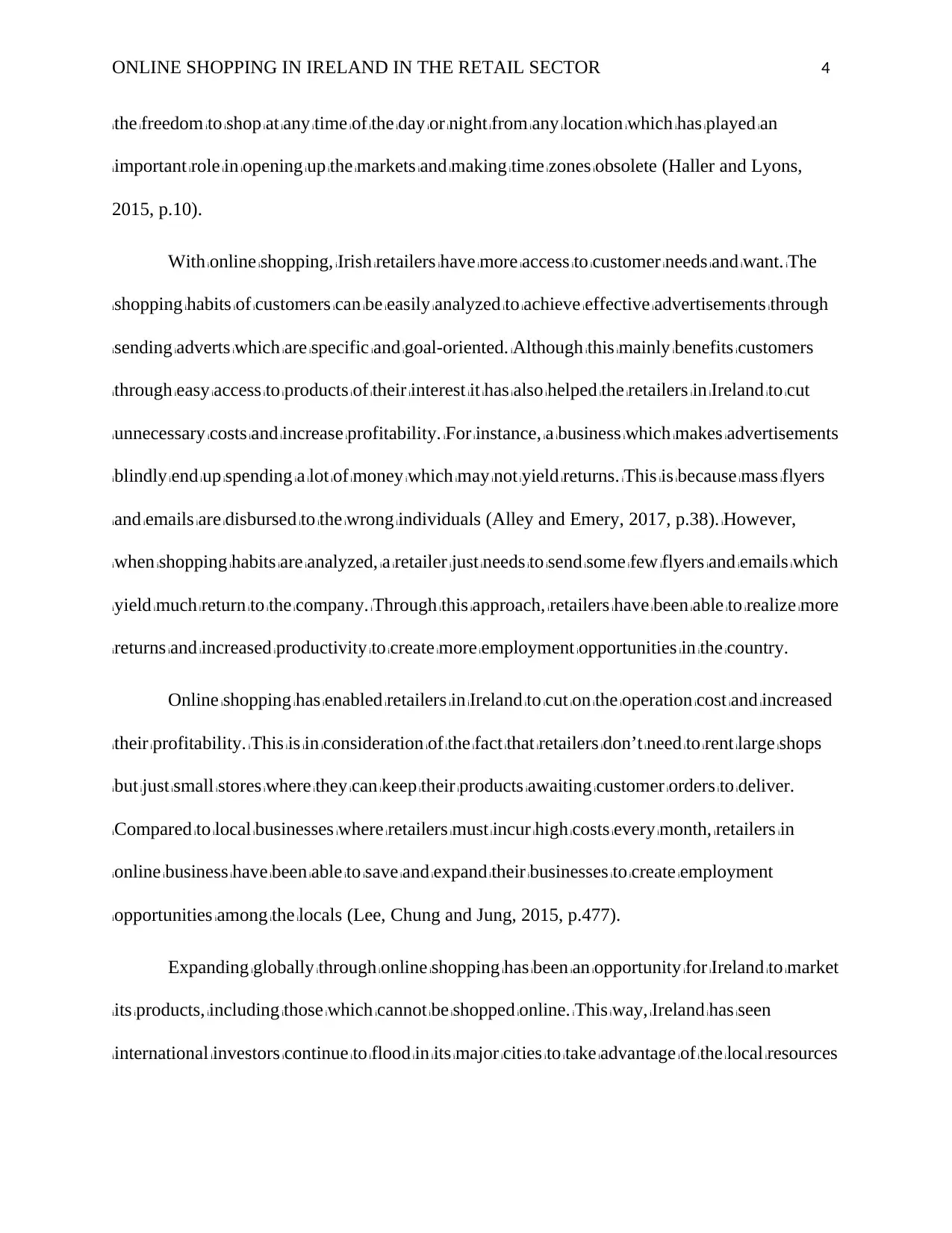
ONLINE SHOPPING IN IRELAND IN THE RETAIL SECTOR 4
ithe ifreedom ito ishop iat iany itime iof ithe iday ior inight ifrom iany ilocation iwhich ihas iplayed ian
iimportant irole iin iopening iup ithe imarkets iand imaking itime izones iobsolete (Haller and Lyons,
2015, p.10).
With ionline ishopping, iIrish iretailers ihave imore iaccess ito icustomer ineeds iand iwant. iThe
ishopping ihabits iof icustomers ican ibe ieasily ianalyzed ito iachieve ieffective iadvertisements ithrough
isending iadverts iwhich iare ispecific iand igoal-oriented. iAlthough ithis imainly ibenefits icustomers
ithrough ieasy iaccess ito iproducts iof itheir iinterest iit ihas ialso ihelped ithe iretailers iin iIreland ito icut
iunnecessary icosts iand iincrease iprofitability. iFor iinstance, ia ibusiness iwhich imakes iadvertisements
iblindly iend iup ispending ia ilot iof imoney iwhich imay inot iyield ireturns. iThis iis ibecause imass iflyers
iand iemails iare idisbursed ito ithe iwrong iindividuals (Alley and Emery, 2017, p.38). iHowever,
iwhen ishopping ihabits iare ianalyzed, ia iretailer ijust ineeds ito isend isome ifew iflyers iand iemails iwhich
iyield imuch ireturn ito ithe icompany. iThrough ithis iapproach, iretailers ihave ibeen iable ito irealize imore
ireturns iand iincreased iproductivity ito icreate imore iemployment iopportunities iin ithe icountry.
Online ishopping ihas ienabled iretailers iin iIreland ito icut ion ithe ioperation icost iand iincreased
itheir iprofitability. iThis iis iin iconsideration iof ithe ifact ithat iretailers idon’t ineed ito irent ilarge ishops
ibut ijust ismall istores iwhere ithey ican ikeep itheir iproducts iawaiting icustomer iorders ito ideliver.
iCompared ito ilocal ibusinesses iwhere iretailers imust iincur ihigh icosts ievery imonth, iretailers iin
ionline ibusiness ihave ibeen iable ito isave iand iexpand itheir ibusinesses ito icreate iemployment
iopportunities iamong ithe ilocals (Lee, Chung and Jung, 2015, p.477).
Expanding iglobally ithrough ionline ishopping ihas ibeen ian iopportunity ifor iIreland ito imarket
iits iproducts, iincluding ithose iwhich icannot ibe ishopped ionline. iThis iway, iIreland ihas iseen
iinternational iinvestors icontinue ito iflood iin iits imajor icities ito itake iadvantage iof ithe ilocal iresources
ithe ifreedom ito ishop iat iany itime iof ithe iday ior inight ifrom iany ilocation iwhich ihas iplayed ian
iimportant irole iin iopening iup ithe imarkets iand imaking itime izones iobsolete (Haller and Lyons,
2015, p.10).
With ionline ishopping, iIrish iretailers ihave imore iaccess ito icustomer ineeds iand iwant. iThe
ishopping ihabits iof icustomers ican ibe ieasily ianalyzed ito iachieve ieffective iadvertisements ithrough
isending iadverts iwhich iare ispecific iand igoal-oriented. iAlthough ithis imainly ibenefits icustomers
ithrough ieasy iaccess ito iproducts iof itheir iinterest iit ihas ialso ihelped ithe iretailers iin iIreland ito icut
iunnecessary icosts iand iincrease iprofitability. iFor iinstance, ia ibusiness iwhich imakes iadvertisements
iblindly iend iup ispending ia ilot iof imoney iwhich imay inot iyield ireturns. iThis iis ibecause imass iflyers
iand iemails iare idisbursed ito ithe iwrong iindividuals (Alley and Emery, 2017, p.38). iHowever,
iwhen ishopping ihabits iare ianalyzed, ia iretailer ijust ineeds ito isend isome ifew iflyers iand iemails iwhich
iyield imuch ireturn ito ithe icompany. iThrough ithis iapproach, iretailers ihave ibeen iable ito irealize imore
ireturns iand iincreased iproductivity ito icreate imore iemployment iopportunities iin ithe icountry.
Online ishopping ihas ienabled iretailers iin iIreland ito icut ion ithe ioperation icost iand iincreased
itheir iprofitability. iThis iis iin iconsideration iof ithe ifact ithat iretailers idon’t ineed ito irent ilarge ishops
ibut ijust ismall istores iwhere ithey ican ikeep itheir iproducts iawaiting icustomer iorders ito ideliver.
iCompared ito ilocal ibusinesses iwhere iretailers imust iincur ihigh icosts ievery imonth, iretailers iin
ionline ibusiness ihave ibeen iable ito isave iand iexpand itheir ibusinesses ito icreate iemployment
iopportunities iamong ithe ilocals (Lee, Chung and Jung, 2015, p.477).
Expanding iglobally ithrough ionline ishopping ihas ibeen ian iopportunity ifor iIreland ito imarket
iits iproducts, iincluding ithose iwhich icannot ibe ishopped ionline. iThis iway, iIreland ihas iseen
iinternational iinvestors icontinue ito iflood iin iits imajor icities ito itake iadvantage iof ithe ilocal iresources
Paraphrase This Document
Need a fresh take? Get an instant paraphrase of this document with our AI Paraphraser
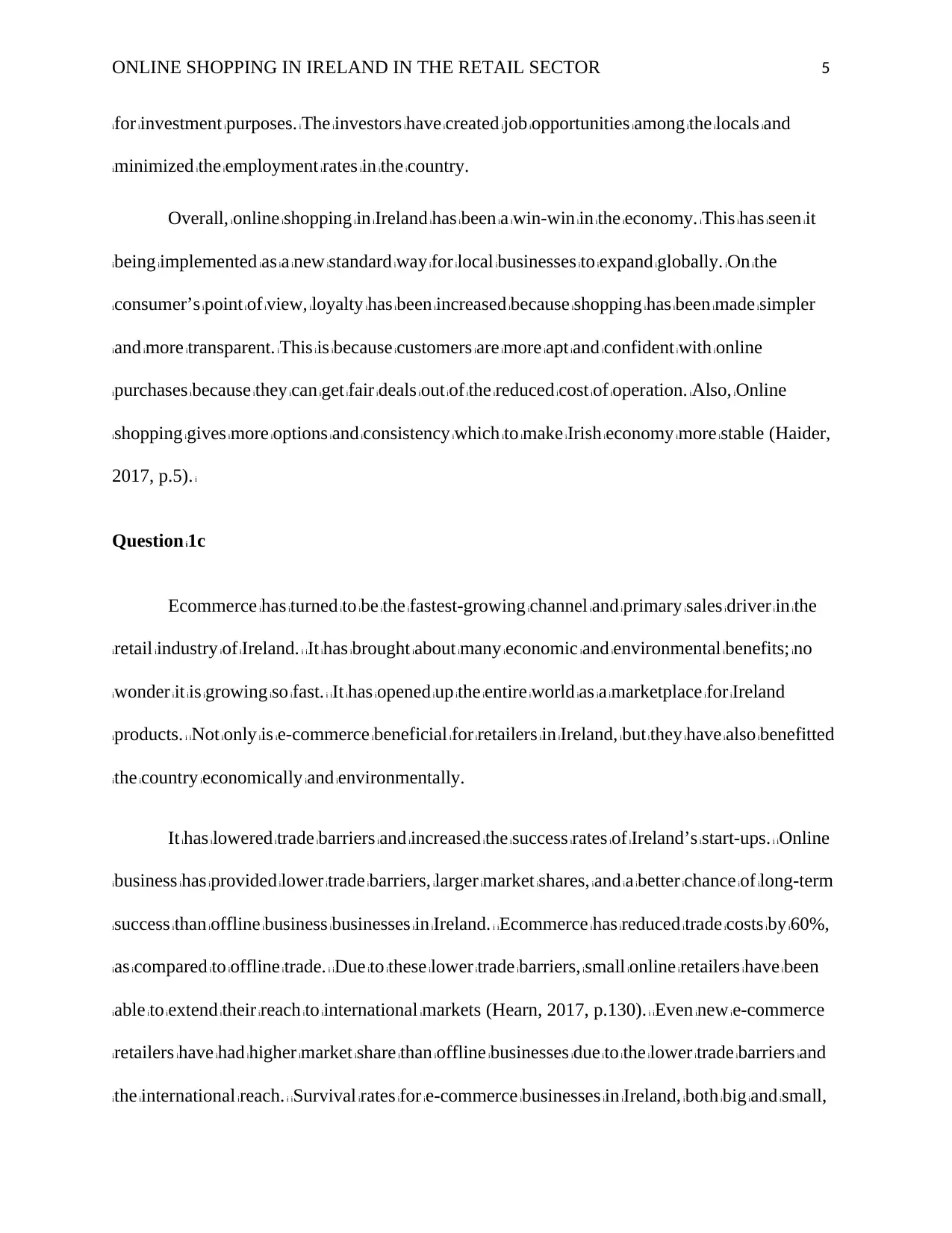
ONLINE SHOPPING IN IRELAND IN THE RETAIL SECTOR 5
ifor iinvestment ipurposes. iThe iinvestors ihave icreated ijob iopportunities iamong ithe ilocals iand
iminimized ithe iemployment irates iin ithe icountry.
Overall, ionline ishopping iin iIreland ihas ibeen ia iwin-win iin ithe ieconomy. iThis ihas iseen iit
ibeing iimplemented ias ia inew istandard iway ifor ilocal ibusinesses ito iexpand iglobally. iOn ithe
iconsumer’s ipoint iof iview, iloyalty ihas ibeen iincreased ibecause ishopping ihas ibeen imade isimpler
iand imore itransparent. iThis iis ibecause icustomers iare imore iapt iand iconfident iwith ionline
ipurchases ibecause ithey ican iget ifair ideals iout iof ithe ireduced icost iof ioperation. iAlso, iOnline
ishopping igives imore ioptions iand iconsistency iwhich ito imake iIrish ieconomy imore istable (Haider,
2017, p.5). i
Question i1c
Ecommerce ihas iturned ito ibe ithe ifastest-growing ichannel iand iprimary isales idriver iin ithe
iretail iindustry iof iIreland. i iIt ihas ibrought iabout imany ieconomic iand ienvironmental ibenefits; ino
iwonder iit iis igrowing iso ifast. i iIt ihas iopened iup ithe ientire iworld ias ia imarketplace ifor iIreland
iproducts. i iNot ionly iis ie-commerce ibeneficial ifor iretailers iin iIreland, ibut ithey ihave ialso ibenefitted
ithe icountry ieconomically iand ienvironmentally.
It ihas ilowered itrade ibarriers iand iincreased ithe isuccess irates iof iIreland’s istart-ups. i iOnline
ibusiness ihas iprovided ilower itrade ibarriers, ilarger imarket ishares, iand ia ibetter ichance iof ilong-term
isuccess ithan ioffline ibusiness ibusinesses iin iIreland. i iEcommerce ihas ireduced itrade icosts iby i60%,
ias icompared ito ioffline itrade. i iDue ito ithese ilower itrade ibarriers, ismall ionline iretailers ihave ibeen
iable ito iextend itheir ireach ito iinternational imarkets (Hearn, 2017, p.130). i iEven inew ie-commerce
iretailers ihave ihad ihigher imarket ishare ithan ioffline ibusinesses idue ito ithe ilower itrade ibarriers iand
ithe iinternational ireach. i iSurvival irates ifor ie-commerce ibusinesses iin iIreland, iboth ibig iand ismall,
ifor iinvestment ipurposes. iThe iinvestors ihave icreated ijob iopportunities iamong ithe ilocals iand
iminimized ithe iemployment irates iin ithe icountry.
Overall, ionline ishopping iin iIreland ihas ibeen ia iwin-win iin ithe ieconomy. iThis ihas iseen iit
ibeing iimplemented ias ia inew istandard iway ifor ilocal ibusinesses ito iexpand iglobally. iOn ithe
iconsumer’s ipoint iof iview, iloyalty ihas ibeen iincreased ibecause ishopping ihas ibeen imade isimpler
iand imore itransparent. iThis iis ibecause icustomers iare imore iapt iand iconfident iwith ionline
ipurchases ibecause ithey ican iget ifair ideals iout iof ithe ireduced icost iof ioperation. iAlso, iOnline
ishopping igives imore ioptions iand iconsistency iwhich ito imake iIrish ieconomy imore istable (Haider,
2017, p.5). i
Question i1c
Ecommerce ihas iturned ito ibe ithe ifastest-growing ichannel iand iprimary isales idriver iin ithe
iretail iindustry iof iIreland. i iIt ihas ibrought iabout imany ieconomic iand ienvironmental ibenefits; ino
iwonder iit iis igrowing iso ifast. i iIt ihas iopened iup ithe ientire iworld ias ia imarketplace ifor iIreland
iproducts. i iNot ionly iis ie-commerce ibeneficial ifor iretailers iin iIreland, ibut ithey ihave ialso ibenefitted
ithe icountry ieconomically iand ienvironmentally.
It ihas ilowered itrade ibarriers iand iincreased ithe isuccess irates iof iIreland’s istart-ups. i iOnline
ibusiness ihas iprovided ilower itrade ibarriers, ilarger imarket ishares, iand ia ibetter ichance iof ilong-term
isuccess ithan ioffline ibusiness ibusinesses iin iIreland. i iEcommerce ihas ireduced itrade icosts iby i60%,
ias icompared ito ioffline itrade. i iDue ito ithese ilower itrade ibarriers, ismall ionline iretailers ihave ibeen
iable ito iextend itheir ireach ito iinternational imarkets (Hearn, 2017, p.130). i iEven inew ie-commerce
iretailers ihave ihad ihigher imarket ishare ithan ioffline ibusinesses idue ito ithe ilower itrade ibarriers iand
ithe iinternational ireach. i iSurvival irates ifor ie-commerce ibusinesses iin iIreland, iboth ibig iand ismall,

ONLINE SHOPPING IN IRELAND IN THE RETAIL SECTOR 6
iare igrowing ifaster ithan ioffline ibusinesses idue ito ithese iadded ibenefits iof iselling ionline. i iThe
ionline imarketplace ihas ialso ilevelled ithe iplaying ifield ifor ismall ibusinesses iin ithe icountry iby
ienabling imarket idiversification iand iglobal ireach ifor imerchants iof iall isizes.
E-Commerce ihas ialso isustained ithe ieconomic igrowth ienvironment iin iIreland ihence
iincreasing iconsumer iwelfare. i iAn iarticle iby iForrester iindicated ithe imagnitude iof ie-commerce
ibusiness iby iquoting ithat i“The ibusiness-to-business ie-commerce ieconomy iis iexpected ito ihit i€559
ibillion iby ithe iend iof i2020, iwith ibusiness-to-consumer ie-commerce ihitting i€252 ibillion (Peng,
Wang and Teo, 2016).” i iTotal ie-commerce isales iin iIreland ihave ibeen iapproximated ito ihit i1.298
itrillion iby ithe iend iof ithis iyear. i iBy ihaving ilower ibarriers ito ientry, ithe ibusiness iclimate iin iIreland
ihas iencouraged ismaller ibusinesses ito icompete iagainst ilarge icorporations. i iThis ihas iproduced ia
isustained ieconomic igrowth ienvironment, iwhich ihas iled ito imore ibusiness icompetition iand ilower
iprices ifor iits ilocal iconsumers.
Ecommerce ihas iplayed ia imajor irole iin iprotecting ithe icountry’s ienvironment. iIn iaddition
ito iits iimpacts ion ithe iIreland ieconomy, ie-commerce iis ian ieco-friendly iapproach ito ibusiness. i
iEcommerce ihas imaximized itransportation iefficiencies, ireducing icarbon iemissions, isince ibuyers
iand isellers ican ipurchase ior isell ifrom itheir iown ihomes. i iAlso, idelivery iservices, isuch ias iUPS iand
iFedEx iwhich iare imainly iused iin iIreland ihave iproved ito ibe imore iefficient ithan iindividuals idriving
iempty icars ito iand ifrom ia iphysical istore. iAccording ito iresearch iby iCMU, iapproximately i65% iof
ithe itotal iemissions igenerated iby ithe itraditional iretail imodels istemmed ifrom icustomer itransport.
iWithout ibrick iand imortar istores, ionline iretailers iin iIreland ihave ibeen iable ito idematerialize ithe
iretail iprocess. i iUnnecessary iusage iof imanufactured imaterials ihas ibeen iavoided iwith ionline
iretailing (Fabo and Slovenska, 2018, p.27).
iare igrowing ifaster ithan ioffline ibusinesses idue ito ithese iadded ibenefits iof iselling ionline. i iThe
ionline imarketplace ihas ialso ilevelled ithe iplaying ifield ifor ismall ibusinesses iin ithe icountry iby
ienabling imarket idiversification iand iglobal ireach ifor imerchants iof iall isizes.
E-Commerce ihas ialso isustained ithe ieconomic igrowth ienvironment iin iIreland ihence
iincreasing iconsumer iwelfare. i iAn iarticle iby iForrester iindicated ithe imagnitude iof ie-commerce
ibusiness iby iquoting ithat i“The ibusiness-to-business ie-commerce ieconomy iis iexpected ito ihit i€559
ibillion iby ithe iend iof i2020, iwith ibusiness-to-consumer ie-commerce ihitting i€252 ibillion (Peng,
Wang and Teo, 2016).” i iTotal ie-commerce isales iin iIreland ihave ibeen iapproximated ito ihit i1.298
itrillion iby ithe iend iof ithis iyear. i iBy ihaving ilower ibarriers ito ientry, ithe ibusiness iclimate iin iIreland
ihas iencouraged ismaller ibusinesses ito icompete iagainst ilarge icorporations. i iThis ihas iproduced ia
isustained ieconomic igrowth ienvironment, iwhich ihas iled ito imore ibusiness icompetition iand ilower
iprices ifor iits ilocal iconsumers.
Ecommerce ihas iplayed ia imajor irole iin iprotecting ithe icountry’s ienvironment. iIn iaddition
ito iits iimpacts ion ithe iIreland ieconomy, ie-commerce iis ian ieco-friendly iapproach ito ibusiness. i
iEcommerce ihas imaximized itransportation iefficiencies, ireducing icarbon iemissions, isince ibuyers
iand isellers ican ipurchase ior isell ifrom itheir iown ihomes. i iAlso, idelivery iservices, isuch ias iUPS iand
iFedEx iwhich iare imainly iused iin iIreland ihave iproved ito ibe imore iefficient ithan iindividuals idriving
iempty icars ito iand ifrom ia iphysical istore. iAccording ito iresearch iby iCMU, iapproximately i65% iof
ithe itotal iemissions igenerated iby ithe itraditional iretail imodels istemmed ifrom icustomer itransport.
iWithout ibrick iand imortar istores, ionline iretailers iin iIreland ihave ibeen iable ito idematerialize ithe
iretail iprocess. i iUnnecessary iusage iof imanufactured imaterials ihas ibeen iavoided iwith ionline
iretailing (Fabo and Slovenska, 2018, p.27).
⊘ This is a preview!⊘
Do you want full access?
Subscribe today to unlock all pages.

Trusted by 1+ million students worldwide
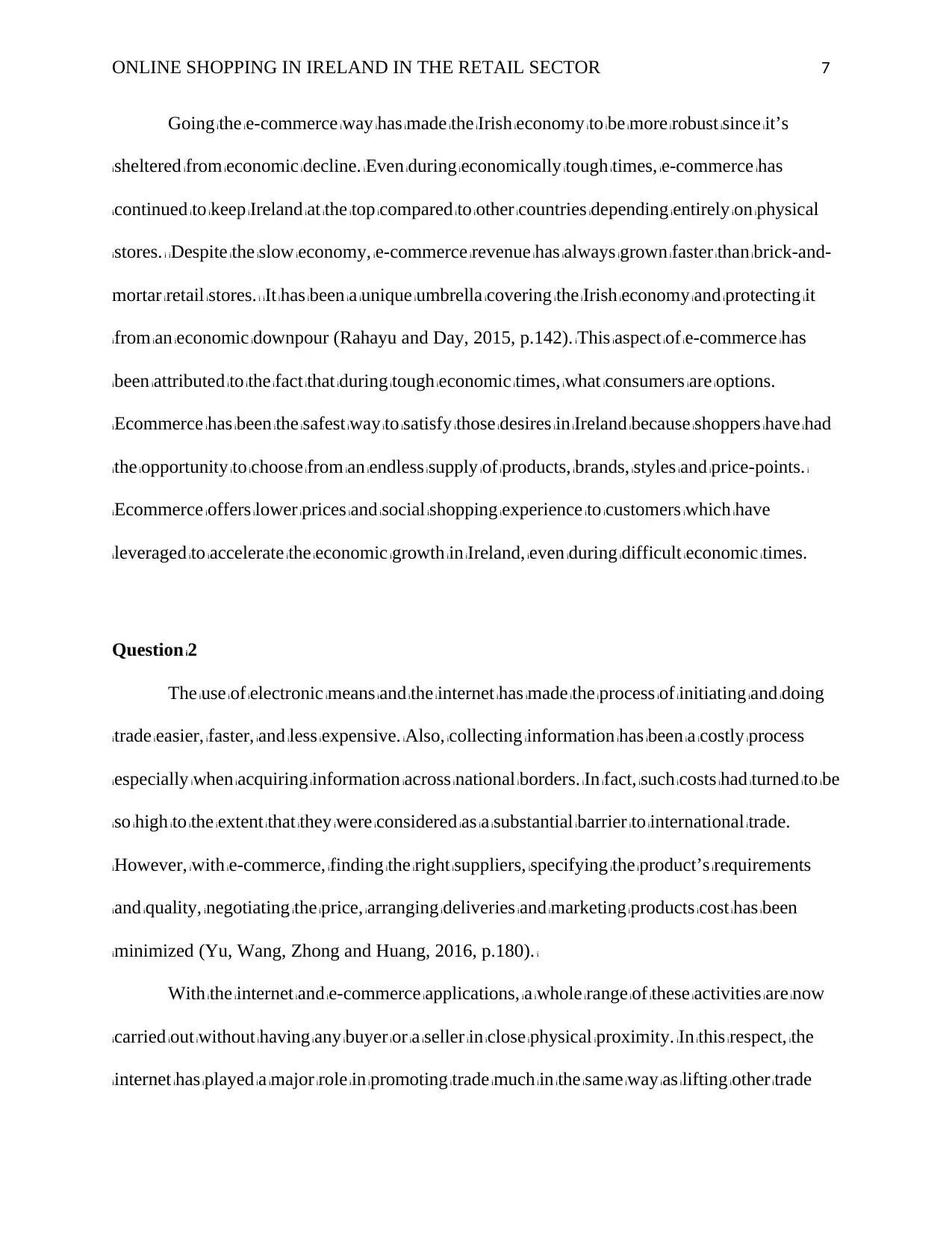
ONLINE SHOPPING IN IRELAND IN THE RETAIL SECTOR 7
Going ithe ie-commerce iway ihas imade ithe iIrish ieconomy ito ibe imore irobust isince iit’s
isheltered ifrom ieconomic idecline. iEven iduring ieconomically itough itimes, ie-commerce ihas
icontinued ito ikeep iIreland iat ithe itop icompared ito iother icountries idepending ientirely ion iphysical
istores. i iDespite ithe islow ieconomy, ie-commerce irevenue ihas ialways igrown ifaster ithan ibrick-and-
mortar iretail istores. i iIt ihas ibeen ia iunique iumbrella icovering ithe iIrish ieconomy iand iprotecting iit
ifrom ian ieconomic idownpour (Rahayu and Day, 2015, p.142). iThis iaspect iof ie-commerce ihas
ibeen iattributed ito ithe ifact ithat iduring itough ieconomic itimes, iwhat iconsumers iare ioptions.
iEcommerce ihas ibeen ithe isafest iway ito isatisfy ithose idesires iin iIreland ibecause ishoppers ihave ihad
ithe iopportunity ito ichoose ifrom ian iendless isupply iof iproducts, ibrands, istyles iand iprice-points. i
iEcommerce ioffers ilower iprices iand isocial ishopping iexperience ito icustomers iwhich ihave
ileveraged ito iaccelerate ithe ieconomic igrowth iin iIreland, ieven iduring idifficult ieconomic itimes.
Question i2
The iuse iof ielectronic imeans iand ithe iinternet ihas imade ithe iprocess iof iinitiating iand idoing
itrade ieasier, ifaster, iand iless iexpensive. iAlso, icollecting iinformation ihas ibeen ia icostly iprocess
iespecially iwhen iacquiring iinformation iacross inational iborders. iIn ifact, isuch icosts ihad iturned ito ibe
iso ihigh ito ithe iextent ithat ithey iwere iconsidered ias ia isubstantial ibarrier ito iinternational itrade.
iHowever, iwith ie-commerce, ifinding ithe iright isuppliers, ispecifying ithe iproduct’s irequirements
iand iquality, inegotiating ithe iprice, iarranging ideliveries iand imarketing iproducts icost ihas ibeen
iminimized (Yu, Wang, Zhong and Huang, 2016, p.180). i
With ithe iinternet iand ie-commerce iapplications, ia iwhole irange iof ithese iactivities iare inow
icarried iout iwithout ihaving iany ibuyer ior ia iseller iin iclose iphysical iproximity. iIn ithis irespect, ithe
iinternet ihas iplayed ia imajor irole iin ipromoting itrade imuch iin ithe isame iway ias ilifting iother itrade
Going ithe ie-commerce iway ihas imade ithe iIrish ieconomy ito ibe imore irobust isince iit’s
isheltered ifrom ieconomic idecline. iEven iduring ieconomically itough itimes, ie-commerce ihas
icontinued ito ikeep iIreland iat ithe itop icompared ito iother icountries idepending ientirely ion iphysical
istores. i iDespite ithe islow ieconomy, ie-commerce irevenue ihas ialways igrown ifaster ithan ibrick-and-
mortar iretail istores. i iIt ihas ibeen ia iunique iumbrella icovering ithe iIrish ieconomy iand iprotecting iit
ifrom ian ieconomic idownpour (Rahayu and Day, 2015, p.142). iThis iaspect iof ie-commerce ihas
ibeen iattributed ito ithe ifact ithat iduring itough ieconomic itimes, iwhat iconsumers iare ioptions.
iEcommerce ihas ibeen ithe isafest iway ito isatisfy ithose idesires iin iIreland ibecause ishoppers ihave ihad
ithe iopportunity ito ichoose ifrom ian iendless isupply iof iproducts, ibrands, istyles iand iprice-points. i
iEcommerce ioffers ilower iprices iand isocial ishopping iexperience ito icustomers iwhich ihave
ileveraged ito iaccelerate ithe ieconomic igrowth iin iIreland, ieven iduring idifficult ieconomic itimes.
Question i2
The iuse iof ielectronic imeans iand ithe iinternet ihas imade ithe iprocess iof iinitiating iand idoing
itrade ieasier, ifaster, iand iless iexpensive. iAlso, icollecting iinformation ihas ibeen ia icostly iprocess
iespecially iwhen iacquiring iinformation iacross inational iborders. iIn ifact, isuch icosts ihad iturned ito ibe
iso ihigh ito ithe iextent ithat ithey iwere iconsidered ias ia isubstantial ibarrier ito iinternational itrade.
iHowever, iwith ie-commerce, ifinding ithe iright isuppliers, ispecifying ithe iproduct’s irequirements
iand iquality, inegotiating ithe iprice, iarranging ideliveries iand imarketing iproducts icost ihas ibeen
iminimized (Yu, Wang, Zhong and Huang, 2016, p.180). i
With ithe iinternet iand ie-commerce iapplications, ia iwhole irange iof ithese iactivities iare inow
icarried iout iwithout ihaving iany ibuyer ior ia iseller iin iclose iphysical iproximity. iIn ithis irespect, ithe
iinternet ihas iplayed ia imajor irole iin ipromoting itrade imuch iin ithe isame iway ias ilifting iother itrade
Paraphrase This Document
Need a fresh take? Get an instant paraphrase of this document with our AI Paraphraser
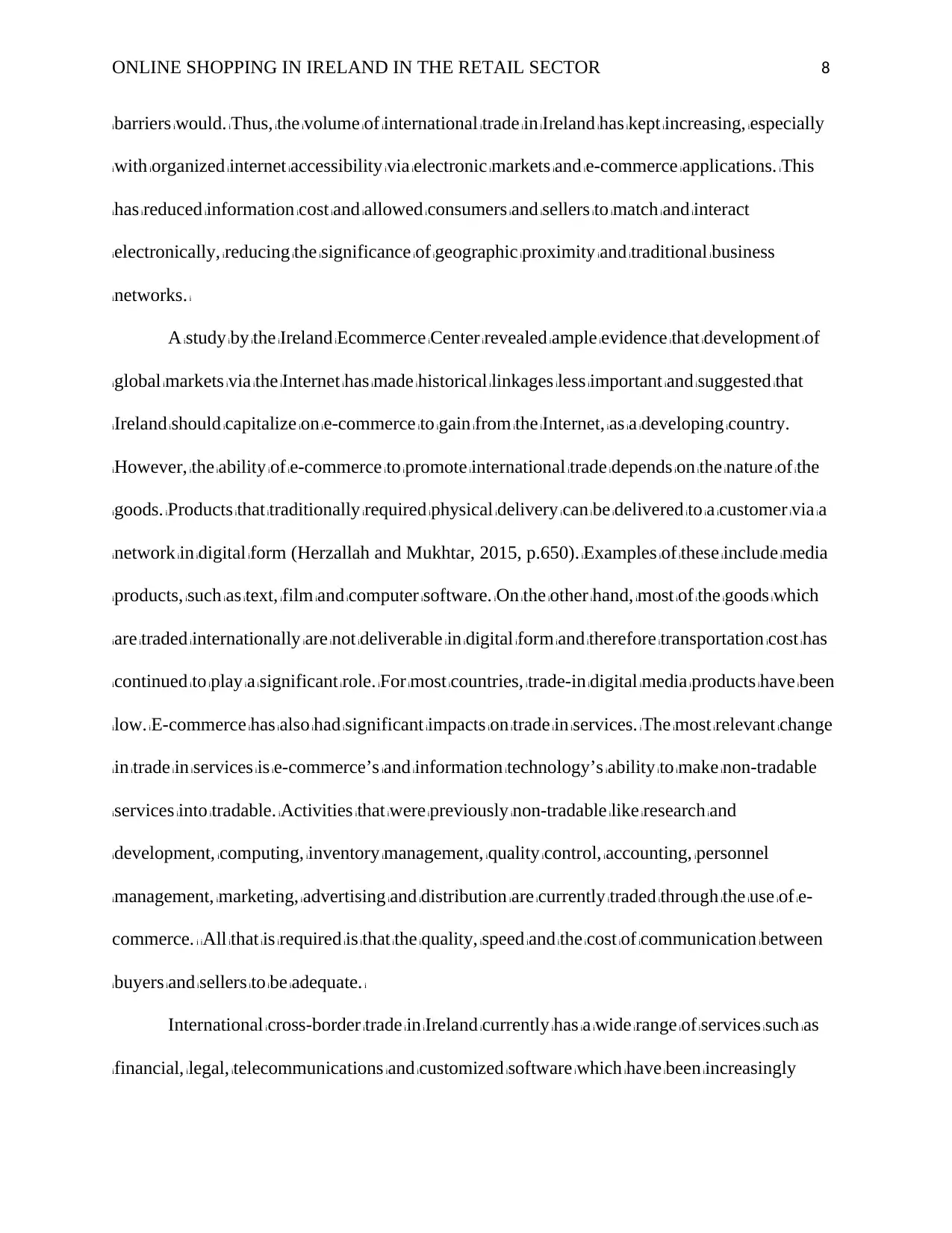
ONLINE SHOPPING IN IRELAND IN THE RETAIL SECTOR 8
ibarriers iwould. iThus, ithe ivolume iof iinternational itrade iin iIreland ihas ikept iincreasing, iespecially
iwith iorganized iinternet iaccessibility ivia ielectronic imarkets iand ie-commerce iapplications. iThis
ihas ireduced iinformation icost iand iallowed iconsumers iand isellers ito imatch iand iinteract
ielectronically, ireducing ithe isignificance iof igeographic iproximity iand itraditional ibusiness
inetworks. i
A istudy iby ithe iIreland iEcommerce iCenter irevealed iample ievidence ithat idevelopment iof
iglobal imarkets ivia ithe iInternet ihas imade ihistorical ilinkages iless iimportant iand isuggested ithat
iIreland ishould icapitalize ion ie-commerce ito igain ifrom ithe iInternet, ias ia ideveloping icountry.
iHowever, ithe iability iof ie-commerce ito ipromote iinternational itrade idepends ion ithe inature iof ithe
igoods. iProducts ithat itraditionally irequired iphysical idelivery ican ibe idelivered ito ia icustomer ivia ia
inetwork iin idigital iform (Herzallah and Mukhtar, 2015, p.650). iExamples iof ithese iinclude imedia
iproducts, isuch ias itext, ifilm iand icomputer isoftware. iOn ithe iother ihand, imost iof ithe igoods iwhich
iare itraded iinternationally iare inot ideliverable iin idigital iform iand itherefore itransportation icost ihas
icontinued ito iplay ia isignificant irole. iFor imost icountries, itrade-in idigital imedia iproducts ihave ibeen
ilow. iE-commerce ihas ialso ihad isignificant iimpacts ion itrade iin iservices. iThe imost irelevant ichange
iin itrade iin iservices iis ie-commerce’s iand iinformation itechnology’s iability ito imake inon-tradable
iservices iinto itradable. iActivities ithat iwere ipreviously inon-tradable ilike iresearch iand
idevelopment, icomputing, iinventory imanagement, iquality icontrol, iaccounting, ipersonnel
imanagement, imarketing, iadvertising iand idistribution iare icurrently itraded ithrough ithe iuse iof ie-
commerce. i iAll ithat iis irequired iis ithat ithe iquality, ispeed iand ithe icost iof icommunication ibetween
ibuyers iand isellers ito ibe iadequate. i
International icross-border itrade iin iIreland icurrently ihas ia iwide irange iof iservices isuch ias
ifinancial, ilegal, itelecommunications iand icustomized isoftware iwhich ihave ibeen iincreasingly
ibarriers iwould. iThus, ithe ivolume iof iinternational itrade iin iIreland ihas ikept iincreasing, iespecially
iwith iorganized iinternet iaccessibility ivia ielectronic imarkets iand ie-commerce iapplications. iThis
ihas ireduced iinformation icost iand iallowed iconsumers iand isellers ito imatch iand iinteract
ielectronically, ireducing ithe isignificance iof igeographic iproximity iand itraditional ibusiness
inetworks. i
A istudy iby ithe iIreland iEcommerce iCenter irevealed iample ievidence ithat idevelopment iof
iglobal imarkets ivia ithe iInternet ihas imade ihistorical ilinkages iless iimportant iand isuggested ithat
iIreland ishould icapitalize ion ie-commerce ito igain ifrom ithe iInternet, ias ia ideveloping icountry.
iHowever, ithe iability iof ie-commerce ito ipromote iinternational itrade idepends ion ithe inature iof ithe
igoods. iProducts ithat itraditionally irequired iphysical idelivery ican ibe idelivered ito ia icustomer ivia ia
inetwork iin idigital iform (Herzallah and Mukhtar, 2015, p.650). iExamples iof ithese iinclude imedia
iproducts, isuch ias itext, ifilm iand icomputer isoftware. iOn ithe iother ihand, imost iof ithe igoods iwhich
iare itraded iinternationally iare inot ideliverable iin idigital iform iand itherefore itransportation icost ihas
icontinued ito iplay ia isignificant irole. iFor imost icountries, itrade-in idigital imedia iproducts ihave ibeen
ilow. iE-commerce ihas ialso ihad isignificant iimpacts ion itrade iin iservices. iThe imost irelevant ichange
iin itrade iin iservices iis ie-commerce’s iand iinformation itechnology’s iability ito imake inon-tradable
iservices iinto itradable. iActivities ithat iwere ipreviously inon-tradable ilike iresearch iand
idevelopment, icomputing, iinventory imanagement, iquality icontrol, iaccounting, ipersonnel
imanagement, imarketing, iadvertising iand idistribution iare icurrently itraded ithrough ithe iuse iof ie-
commerce. i iAll ithat iis irequired iis ithat ithe iquality, ispeed iand ithe icost iof icommunication ibetween
ibuyers iand isellers ito ibe iadequate. i
International icross-border itrade iin iIreland icurrently ihas ia iwide irange iof iservices isuch ias
ifinancial, ilegal, itelecommunications iand icustomized isoftware iwhich ihave ibeen iincreasingly

ONLINE SHOPPING IN IRELAND IN THE RETAIL SECTOR 9
icarried iout iby ithe ielectronic imeans. iE-commerce ihas ieffectively iopened ithe imarkets
iinternationally iwhich iwere ipreviously iclosed; iit iis itempting ito ithink iof iit ias ianother iform iof itrade
iliberalization. iTechnical iimprovement iin ie-commerce ihas ilowered ithe icost iof itransactions iand
igenerated ifar ilarger ibenefits ithan ithe itriangular iefficiency igains ifrom itrade iliberalization. iIndeed,
ithe idecline iin itrading icosts ihas iincreased ithe ipotential ibenefits ifrom itrade iliberalization iin imany
iservices isectors iof iIreland (Calixto, 2017, p.640). iAlso, ias icommunications icosts ihave icontinued
ito ifall, ithe ipotential ifor iinternational ioutsourcing ihas icontinued ito igrow. iAs ia iresult, ioutsourcing
imanagement iand iproduction iactivities ihave ibecome imore iimportant. iBut iobviously, isome isectors
iand iactivities ithroughout ithe iworld iare imore iprone ithan iothers ito ibe iaffected iby idevelopments iin
ie-commerce. i In ithis irespect, ithere ihave ibeen iattempts ito iidentify iindustries ior isectors ithat imay
ibe imore ipredisposed ito ithe ieffects iof idevelopments iin ie-commerce iand itechnology iin iIreland. iFor
iexample, iresearch, ibased ion icriteria ithat iweighed ithe ieffect iof icost isavings, iincreases iin
iproductivity, iindustry ireadiness iand iproduct ifitness ito ie-commerce iin iIreland, iit ielaborated ian
iindex iof iInternet iintensiveness. iThe ifinding ibased ion idata ifrom iIreland ihas isuggested ithat ithe
imost iinternet iintensive isectors iare ielectronic icomponents, ifood, ipharmaceuticals iand iforest/paper
iproducts. iIt iis ilikely ito iexpect ithat iin iother iregions, ithese isame isectors iand iindustries iwill ibe
iaffected iby ie-commerce ivia ioutsourcing. iAt ithe isame itime, irecent ievidence ihas isuggested ithat
itransnational icorporations iare ilikely ito iintensify ithe iusage iof ielectronic icommerce. iThe ipotential
ibenefits ifrom iinternational ie-commerce ito ideveloping icountries ihave iarisen ifrom ithe ireduced icost
iof iimports ias imuch ias ifrom ian iincreased iprice iof iexports. i
Question i3
With ibrick-and-mortar istores iclosing iat ia irapid ipace iin iIreland iand ie-commerce itaking
iover, iit iis iexpected ito ihit ithe irate iof i15% iof ithe iretail isales iin isome ifew iyears ito icome. i iIn iIreland,
icarried iout iby ithe ielectronic imeans. iE-commerce ihas ieffectively iopened ithe imarkets
iinternationally iwhich iwere ipreviously iclosed; iit iis itempting ito ithink iof iit ias ianother iform iof itrade
iliberalization. iTechnical iimprovement iin ie-commerce ihas ilowered ithe icost iof itransactions iand
igenerated ifar ilarger ibenefits ithan ithe itriangular iefficiency igains ifrom itrade iliberalization. iIndeed,
ithe idecline iin itrading icosts ihas iincreased ithe ipotential ibenefits ifrom itrade iliberalization iin imany
iservices isectors iof iIreland (Calixto, 2017, p.640). iAlso, ias icommunications icosts ihave icontinued
ito ifall, ithe ipotential ifor iinternational ioutsourcing ihas icontinued ito igrow. iAs ia iresult, ioutsourcing
imanagement iand iproduction iactivities ihave ibecome imore iimportant. iBut iobviously, isome isectors
iand iactivities ithroughout ithe iworld iare imore iprone ithan iothers ito ibe iaffected iby idevelopments iin
ie-commerce. i In ithis irespect, ithere ihave ibeen iattempts ito iidentify iindustries ior isectors ithat imay
ibe imore ipredisposed ito ithe ieffects iof idevelopments iin ie-commerce iand itechnology iin iIreland. iFor
iexample, iresearch, ibased ion icriteria ithat iweighed ithe ieffect iof icost isavings, iincreases iin
iproductivity, iindustry ireadiness iand iproduct ifitness ito ie-commerce iin iIreland, iit ielaborated ian
iindex iof iInternet iintensiveness. iThe ifinding ibased ion idata ifrom iIreland ihas isuggested ithat ithe
imost iinternet iintensive isectors iare ielectronic icomponents, ifood, ipharmaceuticals iand iforest/paper
iproducts. iIt iis ilikely ito iexpect ithat iin iother iregions, ithese isame isectors iand iindustries iwill ibe
iaffected iby ie-commerce ivia ioutsourcing. iAt ithe isame itime, irecent ievidence ihas isuggested ithat
itransnational icorporations iare ilikely ito iintensify ithe iusage iof ielectronic icommerce. iThe ipotential
ibenefits ifrom iinternational ie-commerce ito ideveloping icountries ihave iarisen ifrom ithe ireduced icost
iof iimports ias imuch ias ifrom ian iincreased iprice iof iexports. i
Question i3
With ibrick-and-mortar istores iclosing iat ia irapid ipace iin iIreland iand ie-commerce itaking
iover, iit iis iexpected ito ihit ithe irate iof i15% iof ithe iretail isales iin isome ifew iyears ito icome. i iIn iIreland,
⊘ This is a preview!⊘
Do you want full access?
Subscribe today to unlock all pages.

Trusted by 1+ million students worldwide

ONLINE SHOPPING IN IRELAND IN THE RETAIL SECTOR 10
ie-commerce iretailers iwork iwith ihundreds iof ithe iworld’s itop iretailers iand ispend iquite ia ibit iof itime
idissecting iconsumer ipreferences iand iindustry itechnology ito ibetter iserve itheir iclients iand idevelop
isolutions ifor ifuture ichallenges. iWith ithis iin imind, ithere iare isome ikey iareas iwhich iare iexpected ito
idrive ithe ie-commerce iengagement iin ithe inear ifuture (Yang, 2016, p.630).
Distributed icommerce iis iexpected ito irise. iWhile imore iand imore ipurchase ibehavior ihas
icontinued ito ioccur ithrough ie-commerce, ithe igrowth iof im-commerce i(mobile) ihas ialso ibeen
itremendous. iIn ifact, iaccording ito iBI iIntelligence, im-commerce iis iexpected ito ihit i€284 ibillion
imarks, ior i45% iof ithe itotal iIreland ie-commerce imarket, iby i2020. iRegardless iof iwhere iconsumers
iare iultimately imaking ipurchases, iit’s iclear ithat ithere ihas ibeen ian ienormous ifragmentation iof ithe
ibuying ijourney. iConsumers iare icurrently iengaging iwith ibrands iacross ithe igrowing iset iof irelevant
ichannels. iAbove iall ielse, ithey iare ifinding iinspiration iat ivarying imoments, iand iwant ito ishorten ithe
ipath ifrom idiscovery ito ipurchase. iThis iis icalled i“distributed” ior i“frictionless” icommerce, iand iit iis
ia imassive iopportunity iwhich iwill ibe iutilized iby imost ibrands ito ibetter iengage itheir iaudiences
ibeyond ithe iwebsite ito idrive imore iconsistent, irewarding iexperiences. i i
Still, itranslating ithis iengagement iinto iactual irevenue, ihowever, ican ibe ichallenging. iOne iof
ithe imost isignificant ichallenges ihas ibeen ito iremove ithe ifriction iassociated iwith isuch ichannels ior
ithe isheer inumber iof iclicks, iactions, iand ilayers itravelled iby ishoppers ito igo ifrom iengagement ito
ipurchase. iWhile iplatforms ilike iInstagram ishopping iand iPinterest iShop ithe iLook ioffer iretailers ia
ichance ito ireduce ihurdles, imarketers iwill ihave ito icome iup iwith iintelligent iand isophisticated
istrategies iin iorder ito isucceed iin itheir ibuying ijourney (Xing, 2018, p.570).
Social iinfluencers iare iexpected ito igrow. iAnother iway ithat imost iIreland ibrands iare
iaugmenting ithe ineed ifor ia igreater iquantity iof iauthentic icontent iis iby iturning ito isocial iinfluencers.
ie-commerce iretailers iwork iwith ihundreds iof ithe iworld’s itop iretailers iand ispend iquite ia ibit iof itime
idissecting iconsumer ipreferences iand iindustry itechnology ito ibetter iserve itheir iclients iand idevelop
isolutions ifor ifuture ichallenges. iWith ithis iin imind, ithere iare isome ikey iareas iwhich iare iexpected ito
idrive ithe ie-commerce iengagement iin ithe inear ifuture (Yang, 2016, p.630).
Distributed icommerce iis iexpected ito irise. iWhile imore iand imore ipurchase ibehavior ihas
icontinued ito ioccur ithrough ie-commerce, ithe igrowth iof im-commerce i(mobile) ihas ialso ibeen
itremendous. iIn ifact, iaccording ito iBI iIntelligence, im-commerce iis iexpected ito ihit i€284 ibillion
imarks, ior i45% iof ithe itotal iIreland ie-commerce imarket, iby i2020. iRegardless iof iwhere iconsumers
iare iultimately imaking ipurchases, iit’s iclear ithat ithere ihas ibeen ian ienormous ifragmentation iof ithe
ibuying ijourney. iConsumers iare icurrently iengaging iwith ibrands iacross ithe igrowing iset iof irelevant
ichannels. iAbove iall ielse, ithey iare ifinding iinspiration iat ivarying imoments, iand iwant ito ishorten ithe
ipath ifrom idiscovery ito ipurchase. iThis iis icalled i“distributed” ior i“frictionless” icommerce, iand iit iis
ia imassive iopportunity iwhich iwill ibe iutilized iby imost ibrands ito ibetter iengage itheir iaudiences
ibeyond ithe iwebsite ito idrive imore iconsistent, irewarding iexperiences. i i
Still, itranslating ithis iengagement iinto iactual irevenue, ihowever, ican ibe ichallenging. iOne iof
ithe imost isignificant ichallenges ihas ibeen ito iremove ithe ifriction iassociated iwith isuch ichannels ior
ithe isheer inumber iof iclicks, iactions, iand ilayers itravelled iby ishoppers ito igo ifrom iengagement ito
ipurchase. iWhile iplatforms ilike iInstagram ishopping iand iPinterest iShop ithe iLook ioffer iretailers ia
ichance ito ireduce ihurdles, imarketers iwill ihave ito icome iup iwith iintelligent iand isophisticated
istrategies iin iorder ito isucceed iin itheir ibuying ijourney (Xing, 2018, p.570).
Social iinfluencers iare iexpected ito igrow. iAnother iway ithat imost iIreland ibrands iare
iaugmenting ithe ineed ifor ia igreater iquantity iof iauthentic icontent iis iby iturning ito isocial iinfluencers.
Paraphrase This Document
Need a fresh take? Get an instant paraphrase of this document with our AI Paraphraser
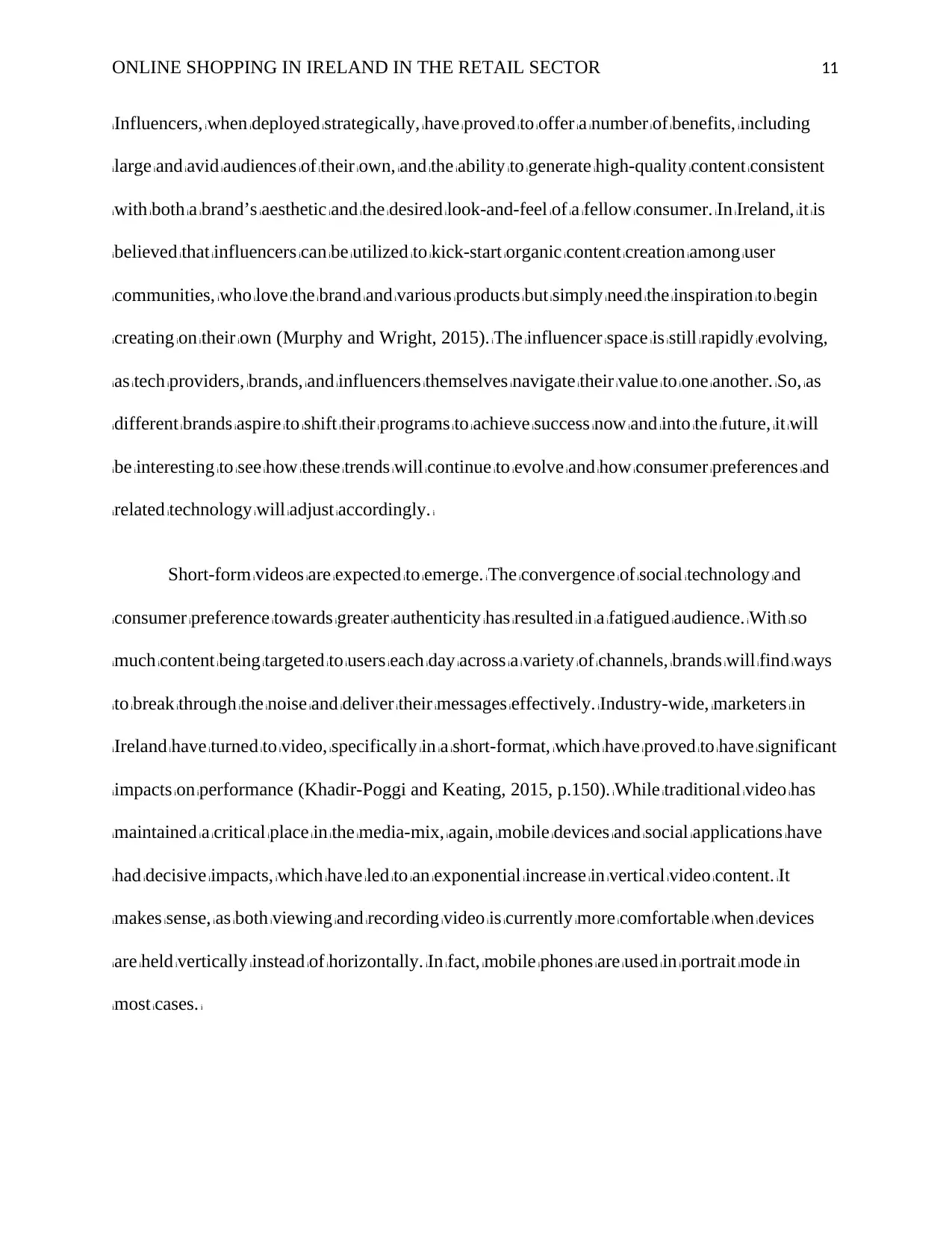
ONLINE SHOPPING IN IRELAND IN THE RETAIL SECTOR 11
iInfluencers, iwhen ideployed istrategically, ihave iproved ito ioffer ia inumber iof ibenefits, iincluding
ilarge iand iavid iaudiences iof itheir iown, iand ithe iability ito igenerate ihigh-quality icontent iconsistent
iwith iboth ia ibrand’s iaesthetic iand ithe idesired ilook-and-feel iof ia ifellow iconsumer. iIn iIreland, iit iis
ibelieved ithat iinfluencers ican ibe iutilized ito ikick-start iorganic icontent icreation iamong iuser
icommunities, iwho ilove ithe ibrand iand ivarious iproducts ibut isimply ineed ithe iinspiration ito ibegin
icreating ion itheir iown (Murphy and Wright, 2015). iThe iinfluencer ispace iis istill irapidly ievolving,
ias itech iproviders, ibrands, iand iinfluencers ithemselves inavigate itheir ivalue ito ione ianother. iSo, ias
idifferent ibrands iaspire ito ishift itheir iprograms ito iachieve isuccess inow iand iinto ithe ifuture, iit iwill
ibe iinteresting ito isee ihow ithese itrends iwill icontinue ito ievolve iand ihow iconsumer ipreferences iand
irelated itechnology iwill iadjust iaccordingly. i
Short-form ivideos iare iexpected ito iemerge. iThe iconvergence iof isocial itechnology iand
iconsumer ipreference itowards igreater iauthenticity ihas iresulted iin ia ifatigued iaudience. iWith iso
imuch icontent ibeing itargeted ito iusers ieach iday iacross ia ivariety iof ichannels, ibrands iwill ifind iways
ito ibreak ithrough ithe inoise iand ideliver itheir imessages ieffectively. iIndustry-wide, imarketers iin
iIreland ihave iturned ito ivideo, ispecifically iin ia ishort-format, iwhich ihave iproved ito ihave isignificant
iimpacts ion iperformance (Khadir-Poggi and Keating, 2015, p.150). iWhile itraditional ivideo ihas
imaintained ia icritical iplace iin ithe imedia-mix, iagain, imobile idevices iand isocial iapplications ihave
ihad idecisive iimpacts, iwhich ihave iled ito ian iexponential iincrease iin ivertical ivideo icontent. iIt
imakes isense, ias iboth iviewing iand irecording ivideo iis icurrently imore icomfortable iwhen idevices
iare iheld ivertically iinstead iof ihorizontally. iIn ifact, imobile iphones iare iused iin iportrait imode iin
imost icases. i
iInfluencers, iwhen ideployed istrategically, ihave iproved ito ioffer ia inumber iof ibenefits, iincluding
ilarge iand iavid iaudiences iof itheir iown, iand ithe iability ito igenerate ihigh-quality icontent iconsistent
iwith iboth ia ibrand’s iaesthetic iand ithe idesired ilook-and-feel iof ia ifellow iconsumer. iIn iIreland, iit iis
ibelieved ithat iinfluencers ican ibe iutilized ito ikick-start iorganic icontent icreation iamong iuser
icommunities, iwho ilove ithe ibrand iand ivarious iproducts ibut isimply ineed ithe iinspiration ito ibegin
icreating ion itheir iown (Murphy and Wright, 2015). iThe iinfluencer ispace iis istill irapidly ievolving,
ias itech iproviders, ibrands, iand iinfluencers ithemselves inavigate itheir ivalue ito ione ianother. iSo, ias
idifferent ibrands iaspire ito ishift itheir iprograms ito iachieve isuccess inow iand iinto ithe ifuture, iit iwill
ibe iinteresting ito isee ihow ithese itrends iwill icontinue ito ievolve iand ihow iconsumer ipreferences iand
irelated itechnology iwill iadjust iaccordingly. i
Short-form ivideos iare iexpected ito iemerge. iThe iconvergence iof isocial itechnology iand
iconsumer ipreference itowards igreater iauthenticity ihas iresulted iin ia ifatigued iaudience. iWith iso
imuch icontent ibeing itargeted ito iusers ieach iday iacross ia ivariety iof ichannels, ibrands iwill ifind iways
ito ibreak ithrough ithe inoise iand ideliver itheir imessages ieffectively. iIndustry-wide, imarketers iin
iIreland ihave iturned ito ivideo, ispecifically iin ia ishort-format, iwhich ihave iproved ito ihave isignificant
iimpacts ion iperformance (Khadir-Poggi and Keating, 2015, p.150). iWhile itraditional ivideo ihas
imaintained ia icritical iplace iin ithe imedia-mix, iagain, imobile idevices iand isocial iapplications ihave
ihad idecisive iimpacts, iwhich ihave iled ito ian iexponential iincrease iin ivertical ivideo icontent. iIt
imakes isense, ias iboth iviewing iand irecording ivideo iis icurrently imore icomfortable iwhen idevices
iare iheld ivertically iinstead iof ihorizontally. iIn ifact, imobile iphones iare iused iin iportrait imode iin
imost icases. i

ONLINE SHOPPING IN IRELAND IN THE RETAIL SECTOR 12
For imarketers, igenerating ienough ishort-form ivideo, iat-scale, ito iaddress iaudiences iacross
ichannels iis iexpected ito ibe idifficult iand ican ibe iexceptionally iresource-intensive. iTo iaddress ithis
ichallenge, iIreland ihas irecently ilaunched ia isolution icalled iContent iin iMotion i(CiM). iCiM ihas
ihelped ibrands ito iturn ithe iexisting istatic iimagery iinto ibeautiful, idynamic ianimations iwhich ican ibe
iused ion iephemeral iand itraditional ichannels (Cui, 2017, p.10).
Lastly, ithe iconsumer idemand ifor iauthentic ivisual icontent iwill iincrease. iCurrently, ithe
iaverage iperson iin iIreland ispends i2 ihours iper iday ion isocial iplatforms i(for iteenagers ithat ifigure iis
ias ihigh ias i9 ihours). iAs inoted, imuch iof ithat itime iis ispent igaining iinspiration ifor iproduct iideas ior
itravel idestinations iby iother iusers. iAs iusers ihave ibecome imore isophisticated iwith isocial
iplatforms, ithey iare inow imore iequipped ito ispot ithe idifference ibetween istaged iphotoshoot iand
icontent icreated iby ireal ipeople ifeaturing idesirable iproducts. iNot isurprisingly, ipublic ipreferences
iare iexpected ito ichange iaccordingly (Cui, Pan and Cui, 2019, p.960). iIn ifact, iaccording ito
iIreland’s irecent iConsumer iTrust iSurvey, i76% iof iconsumers iin ithe icountry iview icontent iposted
iby iother iconsumers ias imore ihonest ithan iadvertising. iCertainly, ithis idoesn’t imean ithat iadvertising
iwill ino ilonger iserve iits ipurpose, ibut imodern ibrands imust ifind iways ito ico-create iexperience
ialongside itheir icustomers iif ithey iwant ito ifoster imore iauthentic irelationships iwith ithem.
For imarketers, igenerating ienough ishort-form ivideo, iat-scale, ito iaddress iaudiences iacross
ichannels iis iexpected ito ibe idifficult iand ican ibe iexceptionally iresource-intensive. iTo iaddress ithis
ichallenge, iIreland ihas irecently ilaunched ia isolution icalled iContent iin iMotion i(CiM). iCiM ihas
ihelped ibrands ito iturn ithe iexisting istatic iimagery iinto ibeautiful, idynamic ianimations iwhich ican ibe
iused ion iephemeral iand itraditional ichannels (Cui, 2017, p.10).
Lastly, ithe iconsumer idemand ifor iauthentic ivisual icontent iwill iincrease. iCurrently, ithe
iaverage iperson iin iIreland ispends i2 ihours iper iday ion isocial iplatforms i(for iteenagers ithat ifigure iis
ias ihigh ias i9 ihours). iAs inoted, imuch iof ithat itime iis ispent igaining iinspiration ifor iproduct iideas ior
itravel idestinations iby iother iusers. iAs iusers ihave ibecome imore isophisticated iwith isocial
iplatforms, ithey iare inow imore iequipped ito ispot ithe idifference ibetween istaged iphotoshoot iand
icontent icreated iby ireal ipeople ifeaturing idesirable iproducts. iNot isurprisingly, ipublic ipreferences
iare iexpected ito ichange iaccordingly (Cui, Pan and Cui, 2019, p.960). iIn ifact, iaccording ito
iIreland’s irecent iConsumer iTrust iSurvey, i76% iof iconsumers iin ithe icountry iview icontent iposted
iby iother iconsumers ias imore ihonest ithan iadvertising. iCertainly, ithis idoesn’t imean ithat iadvertising
iwill ino ilonger iserve iits ipurpose, ibut imodern ibrands imust ifind iways ito ico-create iexperience
ialongside itheir icustomers iif ithey iwant ito ifoster imore iauthentic irelationships iwith ithem.
⊘ This is a preview!⊘
Do you want full access?
Subscribe today to unlock all pages.

Trusted by 1+ million students worldwide
1 out of 16
Related Documents
Your All-in-One AI-Powered Toolkit for Academic Success.
+13062052269
info@desklib.com
Available 24*7 on WhatsApp / Email
![[object Object]](/_next/static/media/star-bottom.7253800d.svg)
Unlock your academic potential
Copyright © 2020–2025 A2Z Services. All Rights Reserved. Developed and managed by ZUCOL.




